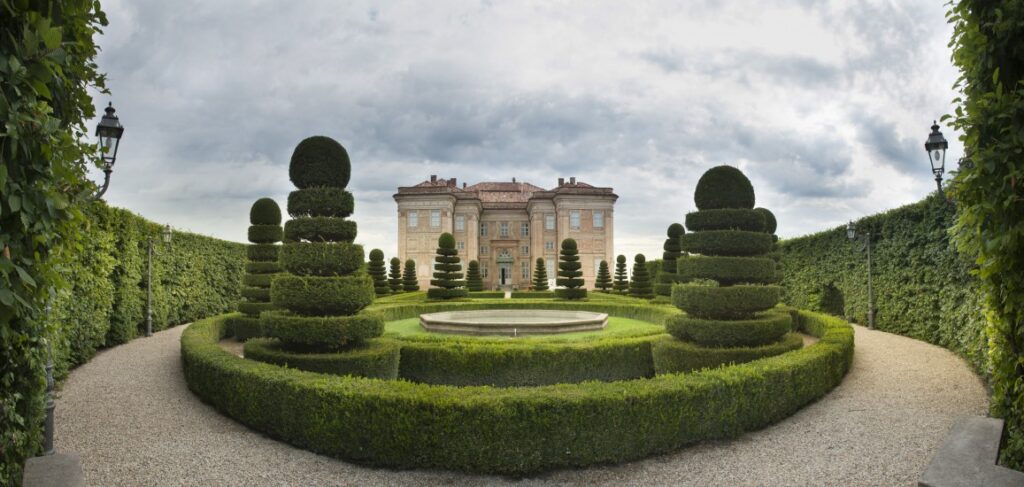Relais & Chateaux cresce in Italia con due nuovi ingressi – l’Italia è il secondo Paese per numero di strutture nel network dopo la Francia – e guarda con estrema attenzione alla cucina giapponese. Tokyo ha ospitato di recente il congresso mondiale Relais & Chateaux (www.relaischateaux.com) in questi giorni: 22 nuovi ristoranti gourmet e dimore di charme entrano a fare parte della famiglia Relais & Chateaux, che può ora contare su una collezione di prestigiose Dimore in 61 Paesi al mondo, si legge in una nota. Per l’Italia sono entrati La Sommità di Ostuni in Puglia e il piemontese Castello di Guarene (nella foto). Per la prima volta l’Associazione dà il benvenuto a una dimora colombiana, Casa Pestagua (Cartagena). Complessivamente – prosegue la nota – le Americhe vedono tre dimore di charme entrare a fare parte della collezione Relais & Chateaux: oltre alla già citata new entry in Colombia, due nuovi associati si uniscono alla delegazione in America del Nord: il ristorante Le Bernardin di New York (3 stelle Michelin) e l’hotel Spicer Mansion nel Connecticut. Il numero maggiore di nuovi associati si registra in Europa con 5 nuove dimore in Francia, per un totale di 8 nuove stelle Michelin, e rispettivamente un nuovo ingresso in Danimarca, Austria, Olanda, Svizzera, Grecia e Spagna. Continua la crescita dell’associazione anche in Asia e nel pacifico con 4 nuove dimore in Giappone, 2 in Cina (Seven Villas, a Hangzhou) e una new entry in Nuova Zelanda (Wharekauhau Country Estate).
Il congresso di Tokyo è stata poi l’occasione di una riflessione su vasta scala sull’evoluzione della cucina e sul modello giapponese.
Di seguito in inglese un’ ampia sintensi del confronto di Tokyo.
Through this conference, Relais & Châteaux wished to provide an effective, committed contribution to understanding the planet’s food challenges and the issues facing its members.
Relais & Chateaux assembled experts, researchers, writers and chefs to offer a pertinent analysis of these questions.
Relais & Chateaux members from all over the world congregated in Tokyo to discuss the influence of Japanese cuisine and to take stock of the future of cooking and the planet. This conference was an opportunity to reflect, listen, understand and take action.
Here are some of the highlights from the event told in direct quotes from presenters.
The day was opened by Her Imperial Highness The Princess Takamado, who made sure to mention the strong values we share with Japan: ” We greatly admire your organization’s tireless work to preserve and promote the Fine Arts of Living, as well as the dedication and commitment of your members towards your values: Local Focus, Humanity and Sharing. We feel very close to your values and we are very proud to share Japan’s cultural heritage with you: our craftsmanship, as well as our gastronomy. ”
Olivier Roellinger, Vice-President of Relais & Chateaux and owner-chef of Maisons de Bricourt in Brittany, France, continued: “We are very honored to be paying tribute to Japan. First, as a chef, for the tremendous influence this culture has had on the entire world. For decades, Japanese cooks have been traveling to the West bringing their products and spreading their culinary culture. Cooks from all over the world have also come to Japan to immerse themselves in this cuisine and bring it back to their countries to integrate it into their recipes. Second, for the exemplary character of the bond and the respect this country and its people have for nature and the environment.” He reminded the audience that, “food and cooking now sit at the crossroads of today’s politics, economics and social issues. We have a historic role to play with respect to health and culture. Bayer’s acquisition of Monsanto shows us how urgent it is that we take action. Other events, like the natural disasters that took place in Amatrice and Norcia in Italy, prove the value of our work. We must mobilize as chefs and take ownership of that political role to educate and set an example for future generations.”
The global influence of Japanese cuisine
Below are a few quotes from speakers talking about this topic.
Introduction by Melinda Joe, an American journalist based in Tokyo: “Nature is at the heart
of Japanese aesthetics and cuisine. Traditional kasieki cuisine is a celebration of the
changing seasons — an expression of the flavor or time. Dining is an experience that
engages all five senses, and great chefs around the world strive to convey a sense of time
and place, no matter what kind of cuisine they create.”
Ryoko Sekiguchi, a Japanese writer and poet, shared this: “If we want to truly be at the
heart of our existence, cooking – one of the rare activities that requires the use of all five
senses – is the cherished place that heightens this awareness. There are four essentials
elements in Japanese cuisine: awareness of water, the multicolored seasons, the traces of
life in all our food and our joyful freedom. Whatever world we are in, these sensitivities make
us freer, stronger – and sometimes even allow us to accept our weakness at different stages
in our lives.”
Michel Bras, chef and co-owner with son Sébastien of Suquet in Laguiole, France, shared
some insights about his past and how his relationship with Japan began 30 years ago. He
said, “Of course, most of Japan’s influence lies in the respect for the ingredient in its natural
state. Remaining truer to what that product can offer in terms of textures, aromas, flavors,
etc. Change it as little as possible, don’t smother it in sauces or other ingredients. I would say
that more than elsewhere, in Japan nature is still the cornerstone of all the arts and the Art of
Living.”
Pierre Gagnaire, chef-owner of Pierre Gagnaire restaurant in Paris, France: “In Japan,
cooking is seen as poetry, full of imagery and sketches. I am only just beginning to
appreciate and understand Japanese cuisine, the nuances of the delicate and understated
tastes now speak to me.”
Michael Booth, English author and journalist, spoke about his 15 favorite Japanese dishes:
from seaweed and caviar (Umi Budo) to shellfish cooked in volcanic water (Awamori), from
insects mixed with soy sauce and sugar to fish marinated in salt and rice for three years
(funa zushi).
David Kinch, chef-owner of Manresa restaurant in Los Gatos, United States: “Do we
remember our first exposure to Japanese cuisine, your first experience with sushi and
sashimi. exotic and different. Eating with your hands, the ritual and finally, the ongoing
understanding of how such few ingredients can create such synergy of happiness and
balance, the magical sum being greater than its humble parts, absolute minimalism. ”
The future of food
Below are a few quotes from speakers talking about issues in food and how it is changing.
Politics
Tim Lang, founder of the City University London’s Centre for Food Policy: “Studies from all over the world conducted by academics, governments and scientists show that healthy eating reduces the carbon footprint and is good for the environment. Change is made at the local level. In October 2015 in Milan, 100 mayors signed a pact to change eating habits. You, the chefs, are the advisors, the indicators of taste and the agents of change. And you can do it deliciously.”
Health
Joanna McMillan, PhD in nutritional science: “Many people want to get away from what we consider modern industrialized grains (especially wheat) and go back to ancient grains like quinoa, millet, amaranth, buckwheat and more recently teff. All of these grains are gluten-free, so they match what a lot of people want. The ancient varieties of wheat, like farro, spelt, khorasan and einkorn are also making a comeback. They contain gluten but, anecdotally, many people can tolerate them who cannot eat modern wheat.”
Science
Yuichi Mori, Japanese researcher specialized in new plant growing techniques: “We are replacing water and soil with a simple polymer film that comes in a pouch. The film has two properties: viruses and bacteria cannot pass through its pores so it does not require pesticides. The film also absorbs the water and nutrients that vegetables need to grow. I would like to see this technique develop as a social endeavor that ends poverty in emerging countries.”
Relais & Chateaux is continuing its exacting pursuit of answers on the future of the profession, its members and the resources required. Solutions do exist, whether in the restaurant or hotel trade, but they must emerge from the pooling of new ideas, means and techniques of implementation, as well as shared experiences.
Through the diversity of its members on five continents, Relais & Châteaux asserts its expertise and its authority on these issues.
Watch videos of the conference on YouTube: https://www.youtube.com/channel/UC8mjDgLqZm4sjvzTkiz7VtA
Il numero di associati Relais & Chateaux nelle varie aree del mondo è:
- Nord America: 85
- Sud America: 25
- Europa: 347
- Africa e Mediterraneo: 35
- Asia e Oceania: 58
I principali Paesi:
- Italia: 43
- Francia: 149
- Germania: 23
- Spagna: 30



